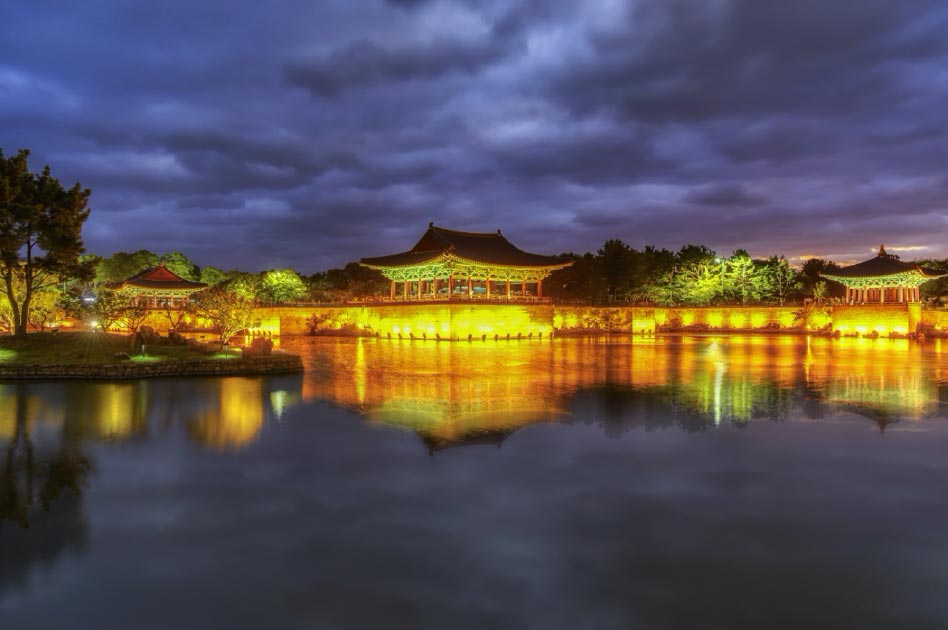Donggung Palace and Wolji Pond: Waters that Reflect the History of South Korea
One of the most beautiful among the many extraordinary sites in South Korea is the architectural remains of Donggung Palace and Wolji Pond, which consists of intricately decorated pagodas overlooking a serene artificial pond. The site is almost 1500 years old and is considered a national treasure by Koreans.
The Majestic History of Donggung Palace And Wolji Pond
The pond and the pavilions were once part of a palace complex in the capital of the kingdom of Silla that ruled the south-east Korean Peninsula for almost a millennium (57 BC-935 AD).
King Munmu, one of the greatest Korean monarchs, briefly unified the Korean kingdoms and this palace complex was built on his orders in 674 AD. He expelled the T’ang Chinese from the peninsula, but despite the conflicts with the Chinese, Silla was deeply influenced by T’ang culture, especially by its larger neighbor’s religions, including Taoism.
Buddhism was also introduced into Silla through contact with China and this is apparent in the construction of the pagodas which are based on classical T’ang architecture. The layout of the pond, once again based on Chinese models, was inspired by Taoism and Buddhist aesthetic principles. Donggung Palace and Wolji Pond were designed not only to be aesthetically pleasing but also to enable individuals to attain inner peace through contemplation.

Visible T’ang architectural influence in the detail of the pavilion roof (Yeongsik Im / Adobe Stock)
The Donggung Palace was the secondary palace of the rulers of the Kingdom of Silla but was the residence of the crown prince who had his own court here. Through the centuries the site was also used for feasting and for diplomatic receptions.
In the 10 th century, aristocratic and peasant rebellions led to the downfall of Silla. Their successors, the Koryŏ monarchs, abandoned the site, leaving it neglected and soon forgotten.
The Korean government had the pond and the pagodas completely rebuilt in the 1970s and 1980s. During the restoration work thousands of historic artifacts from the Silla period were found, including a pottery shard which revealed the pond’s original name. Although known as Anapji for many centuries, the authorities renamed this historic site in the 1980s. The ancient and original name of Wolji, translates to ‘water that reflects the moon’ and is now a popular tourist destination.
What to See at Donggung Palace And Wolji Pond, South Korea
Today the heritage site is located in Gyeongju National Park, in central Gyeongju, South Korea. It is located not far from the site of the main Silla palace at Banwolseong.
- A Stone ‘Throne’: 8th Century Toilet Unearthed at Korean Palace Complex
- The Tang Dynasty: The Arts Flourished, Family Ties Broke, and a Concubine Became Empress
- The Age-Old Bone-Rank Caste System of the Korean Kingdom of Silla

The slanted roof and many supportive columns of the Donggung pavilion (Peter Zyuzin/ Adobe Stock)
The three pavilions were originally built for the benefit of visitors, providing shade and shelter for them. The pavilions, which are built on piers, have traditional Chinese style slanting rooves, supported by numerous columns. These structures have been restored in an authentic manner and visitors can walk through them to view Wolji Pond, just as the kings and princes of the past would have.
The oval shaped pond is about 600 ft (200m) long from east to west and 60 ft (20m) from north to south and has three small islets. The many walkways and gardens around the pond can be explored along with the Buddhist rock garden, which was also designed to encourage meditation.

The islets of Wolji Pond (DeGe Photos / Adobe Stock)
The palace that was once the home of the crown prince no longer stands. During the archaeological investigations at the site in the 1980s, it was found that originally many more buildings bordered the pond and that it was surrounded by a high wall. There were also a number of canals that connected the pond to nearby areas. The restored complex gives us only a hint of what Donggung Palace and Wolji Pond looked like in its heyday during the Silla period.
Visiting Donggung Palace and Wolji Pond
An entrance fee is charged at the site which is open all year around. It is particularly popular at nighttime when the pavilions and pond are lit up.
It is possible to hire an interpreter and guide at Donggung Palace and Wolji Pond, and the museum nearby contains the artifacts that were recovered from the pond. These include statuettes of the Buddha, ornate tiles, and everyday items from the Silla period.
Top image: Donggung Palace and Wolji Pond at sunset Source: ARTIT/ Adobe Stock
By Ed Whelan
References
Ahn, G. B. (2015). C onsideration of Landscape Change Estimation in Donggung-Palace and Wolji-pond of Shilla, Using Materials from the Japanese Ruling Period. Journal of Korean Institute of Traditional Landscape Architecture, 33(1), 12-20
Available at: http://www.koreascience.or.kr/article/JAKO201525749460102.page
Choi, S. H., & You, J. H. (2015). Analysis of Actual Flora and Landscape Planting Species of Donggung Palace and Wolji Pond in Gyeongju. Journal of the Korean Institute of Landscape Architecture, 43(3), 1-12
Available at: http://www.koreascience.or.kr/article/JAKO201521839156055.page
Lee, S., & Leidy, D. P. (2013). Silla: Korea's golden kingdom. Metropolitan Museum of Art.



















